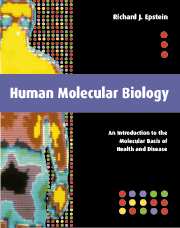Book contents
- Frontmatter
- Contents
- Preface
- Acknowledgements
- Read me first …
- Glossary
- Dedication
- Introduction: A disease for every gene?
- I From molecular biology to human genetics
- II From molecular genetics to human biochemistry
- III From molecular biochemistry to human cell biology
- IV From molecular cell biology to human physiology
- V From molecular physiology to human molecular biology
- 21 Genetic experimental systems
- 22 Gene and protein analysis
- 23 Genetic engineering, gene mapping, and gene testing
- 24 Gene knockouts, transgenics, and cloning
- 25 Gene therapy and recombinant DNA technology
- Index
22 - Gene and protein analysis
Published online by Cambridge University Press: 01 June 2011
- Frontmatter
- Contents
- Preface
- Acknowledgements
- Read me first …
- Glossary
- Dedication
- Introduction: A disease for every gene?
- I From molecular biology to human genetics
- II From molecular genetics to human biochemistry
- III From molecular biochemistry to human cell biology
- IV From molecular cell biology to human physiology
- V From molecular physiology to human molecular biology
- 21 Genetic experimental systems
- 22 Gene and protein analysis
- 23 Genetic engineering, gene mapping, and gene testing
- 24 Gene knockouts, transgenics, and cloning
- 25 Gene therapy and recombinant DNA technology
- Index
Summary
It can be difficult to appraise the significance of research findings without some familiarity of the procedures used. Such knowledge enables the validity of the data to be assessed. In this section we discuss some basic principles underlying laboratory analysis of protein and DNA.
Gels and membranes
Proteins and nucleic acids can be separated within gels
Experimental biology depends on two principles of molecular recognition that underlie the specificity of assay detection:
1. Linear nucleic acids are identified by sequence-specific hybridization with synthetic complementary DNA sequences (oligonucleotide probes).
2. Three-dimensional or denatured protein structures are identified by epitope-specific antibody binding.
Most assays detecting these phenomena involve the electrophoretic separation of molecules using porous jelly-like slabs termed gels. Indeed, for the last two decades, many scientific manuscripts have contained few data other than those involving visualization of molecules within gels. There are many different gel compositions, with the most common being agarose gels (used for separating nucleic acids) and polyacrylamide gels (used for separating proteins).
Gels are modified for specific purposes; for example, formaldehyde is often added to urea-containing agarose gels when RNA is being electrophoresed. Nucleic acids can be visualized on agarose gels by adding the intercalating agent ethidium bromide, which fluoresces on absorbing ultraviolet light. Similarly, the detergent sodium dodecyl sulfate (SDS) is added to protein gels when polypeptide denaturation is desired – denaturation destroys the noncovalent secondary structure of proteins, permitting linearization and hence more accurate electrophoretic measurement of molecular weight.
- Type
- Chapter
- Information
- Human Molecular BiologyAn Introduction to the Molecular Basis of Health and Disease, pp. 546 - 561Publisher: Cambridge University PressPrint publication year: 2002



